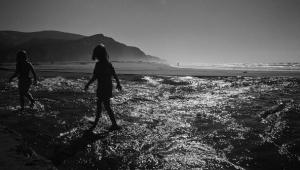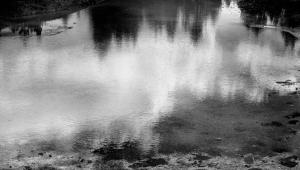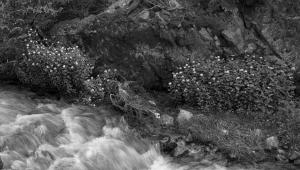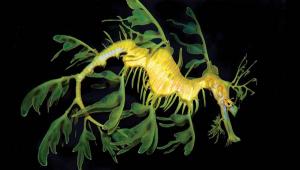The Charms Of Continuous Light: A Great Source For Portraits And Fashion
In the past continuous lights were known as “hot lights”, but today they are often cool and come in a variety of color temperatures, shapes and sizes.
There are a number of creative and practical benefits of continuous studio lights. Many photographers utilizing continuous light will shoot at extremely wide apertures for a narrow depth of field. By shooting f/2.8 or even f/1.2 these apertures allow photographers to bring attention to the eyes by only having the eyes of the subject in focus.
In the portrait of musical artist Pr3pE (#1) the use of a constant ring light (Stellar Lighting Systems, www.stellarlightingsystems.com) creates glowing light, interesting shadows and intriguing catchlights in the eyes. The camera was set at f/2.8 and the subject leaned forward toward the camera, creating an emotional connection with the subject’s eyes.
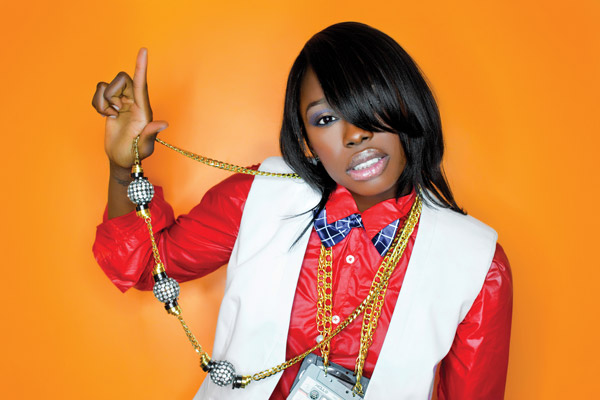
All Photos © Linday Adler
There are several constant light set-ups that allow photographers to create interesting catchlights in the subject’s eyes. In image (#2) the lighting was created by Kino Flo lighting (www.kinoflo.com). These daylight balanced florescent tubes can be arranged into a variety of patterns including a “V” or tic-tac-toe.

Another constant light set-up is the Stellar Lighting Systems 18” constant ring light, utilized in image (#3). This daylight-balanced light creates intriguing circular catchlights in the eyes and stunning, glowing light on the face. A photographer can also shoot at wide apertures with these lights, giving beautifully narrow depth of field.

For photographers experimenting with the video capabilities of their cameras, continuous lights are a must have tool. Video can be a great creative tool and also wonderful as a value-added service for clients. While any continuous lighting will do, many companies like Litepanels (www.litepanels.com) have created LED lighting to be placed on your camera’s hot shoe for convenience of light video on location. Westcott (www.fjwestcott.com) has an entire line of constant lights called “Spiderlites” intended for studio photography and also great for studio video illumination. Constant tungsten hand-held or hot-shoe mounted lights are also a useful video tool, and were used as fill light to light the face of the subject in this portrait (#4). The illumination on the right side of the face was from a studio strobe, while the fill light on the left side of the face is from a hand-held Sunpak tungsten video light (www.tocad.com).

There are also several more practical benefits to constant lights. For example, when photographing children or people uncomfortable with getting their pictures taken, continuous light is a less abrasive form of lighting. People are generally more relaxed and natural when being photographed without the flashing strobes. Another practical benefit for beginning photographers is that “what you see is what you get.” You can actually see the ratios of light and the quality of lights exactly as it will appear in your photo. You can shoot continuous lights the exact same way as you would shoot natural/ambient light. You don’t need to worry about getting the correct strobe exposure or sync speed.
Traditional tungsten hot lights by Westcott were used in (#5) to back light the fog and add mystery to the image. Here the slow shutter speed creates motion blur in the cloth and dancer’s feet.

In this fashion image (#6), the model was illuminated by the modeling lights of the strobes (simple tungsten light bulbs). By utilizing the modeling lights, a longer shutter speed and narrower depth of field could be achieved. This allowed more creative motion blur and a very soft feel to the image.

If you do choose to utilize constant light, you should be aware of two major concerns. First, be careful of mixing color temperatures. For example, if your constant lights are tungsten, then you will not want any daylight mixing into the image and throwing off the color balance. Second, you must be aware of the strength of the lights. More expensive and high-end HMI and constant studio lights (like Kobold, www.bronimaging.com) have very strong outputs. Yet most inexpensive brands have lower outputs and therefore require wider apertures or higher ISOs for some work. Also, typically there are few light modifiers readily available for constant light setups, which may limit some lighting options.
- Log in or register to post comments


